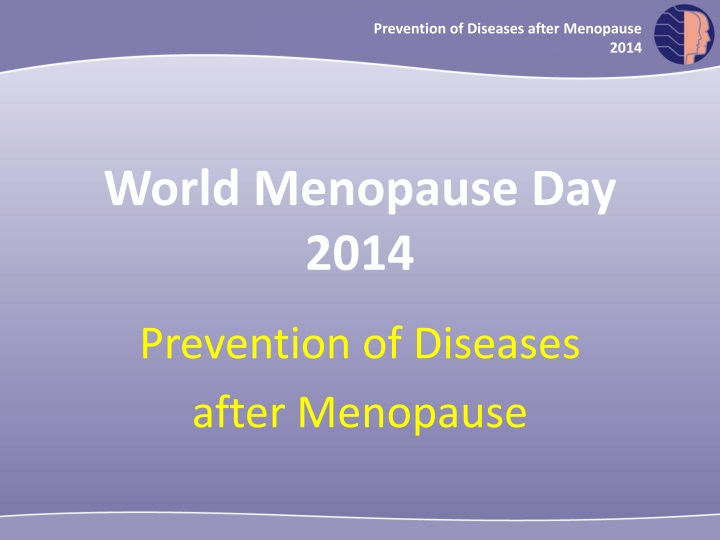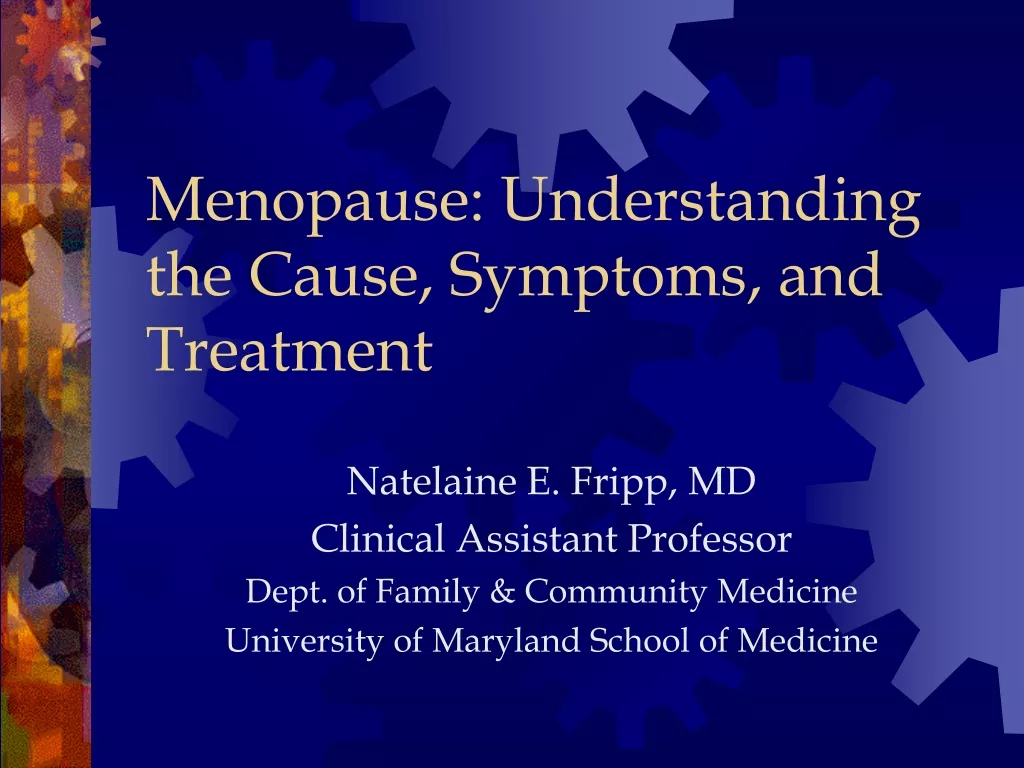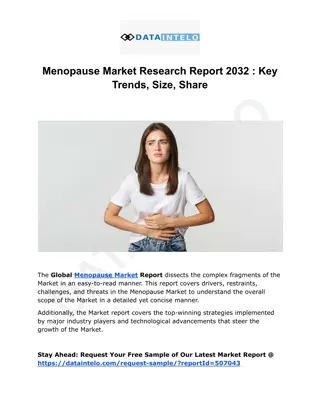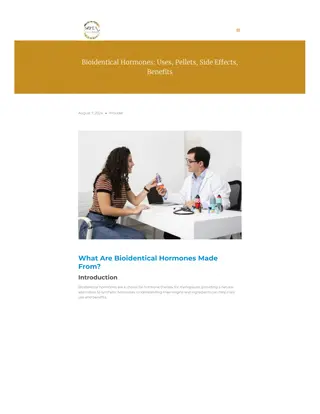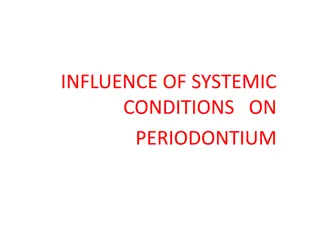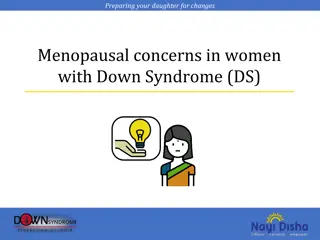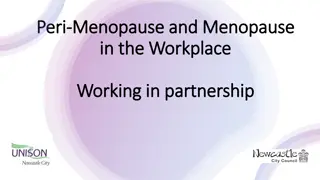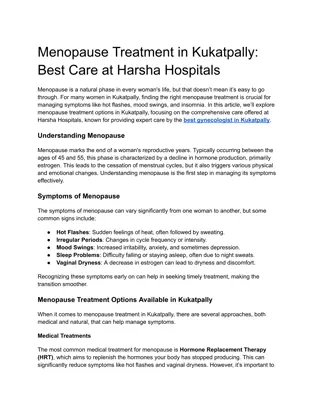World Menopause Day 2014
Millions of women around the world enter menopause, facing risks of chronic diseases such as obesity, diabetes, cardiovascular disease, osteoporosis, dementia, cognitive decline, depression, and cancer. Early identification and prevention strategies are crucial to mitigate these health risks and improve quality of life in the post-menopausal phase.
Download Presentation

Please find below an Image/Link to download the presentation.
The content on the website is provided AS IS for your information and personal use only. It may not be sold, licensed, or shared on other websites without obtaining consent from the author.If you encounter any issues during the download, it is possible that the publisher has removed the file from their server.
You are allowed to download the files provided on this website for personal or commercial use, subject to the condition that they are used lawfully. All files are the property of their respective owners.
The content on the website is provided AS IS for your information and personal use only. It may not be sold, licensed, or shared on other websites without obtaining consent from the author.
E N D
Presentation Transcript
Oncology in midlife and beyond Prevention of Diseases after Menopause 2013 2014 World Menopause Day 2014 Prevention of Diseases after Menopause
Oncology in midlife and beyond Prevention of Diseases after Menopause 2013 2014 Rationale for Prevention Millions of women world-wide are entering Menopause Chronic diseases begin to occur about 10 years after the onset of menopause and are a major source of morbidity, decreased quality of life, mortality and economic burden A major opportunity exists at the onset of menopause to identify risks and initiate prevention strategies to prevent down stream consequences
Oncology in midlife and beyond Prevention of Diseases after Menopause 2013 2014 Chronic Diseases after Menopause Obesity, Metabolic Syndrome and Diabetes Cardiovascular Disease Osteoporosis and Chronic Arthritis Dementia, Cognitive Decline and Depression Cancer
Oncology in midlife and beyond Prevention of Diseases after Menopause 2013 2014 Obesity and Diabetes Approximately 14% of the global population is obese Central adiposity is associated with insulin resistance and Diabetes (Cerhan JR 2014) After menopause body composition changes resulting in central adiposity (android) (Abdulnour J 2012) Prevention and treatment of Obesity include: exercise, caloric restriction and some complementary/alternative approaches. Pharmacotherapy and bariatric surgery may have a role in selective cases (Davis SR 2012) MHT reduces central adiposity and insulin resistance and the onset of Diabetes; it does not cause weight gain (Sorensen MB 2001, Davis SR 2012, Manson JE 2013)
Oncology in midlife and beyond Prevention of Diseases after Menopause 2013 2014 Cardiovascular Disease Coronary Heart Disease is the leading cause of death in women The prevalence of disease while lower than in increases rapidly after menopause; but women fare worse than men after an event (Go AS 2014) Screening for CVD after menopause is important with attention to BP, BMI and lab measurements Various risk calculators are available with low risk being defined as a 10 year risk of an event of <7.5% (AHA 2014) men
Oncology in midlife and beyond Prevention of Diseases after Menopause 2013 2014 Cardiovascular Disease (cont) Diet and life style recommendations (cessation of smoking, exercise, etc.) have been well established; the 10 year coronary risk has been shown to be reduced by 12-14% by life style intervention (Maruthur NM 2009) In contrast to men, for primary prevention in women, statins and aspirin do not have a role (Hodis HN 2013) In healthy women at the onset of menopause, consistent data from many sources suggest that estrogen therapy decreases coronary disease and mortality (Lobo RA 2014)
Oncology in midlife and beyond Prevention of Diseases after Menopause 2013 2014 Osteoporosis and Chronic Arthritis Osteoporosis-related women after age 50 (Johnell O 2005) With increased life expectancy, osteoporosis will increase by 240% by 2050 (Gullberg B 1977) In the US, osteoporosis-related fractures cost over $19 billion; hip fractures account for 72% Prevention strategies include: excessive alcohol, glucocorticoids, and thyroid; preventing falls; moderate weight-bearing exercise; Dietary reference intake of 1200 mg of calcium and 600-800 IU of Vit D (IOM 2010) fractures will affect one third of avoidance of tobacco,
Oncology in midlife and beyond Prevention of Diseases after Menopause 2013 2014 Osteoporosis and Chronic Arthritis (cont) Osteoporosis risk should be assessed using models such as FRAX Pharmacological intervention is advised with a 10-year risk of hip fracture of 5% Options included MHT (De Villiers TJ 2009;2012); SERMS (Ettinger B 1999; Lindsay R 2009); Limited or no role for Bisphosphonates, Denosumab and other agents for prevention Osteoarthritis affects nearly 60 million in the US; is second only to CHD as a cause of work disability > age 50; currently costs over $100 billion Early identification of cases at menopause interventions such as physical therapy, weight loss, exercise, anti- inflammatory agents (Arthritis Foundation 2014) and possibly estrogen (Tanko TB 2007) is important with
Oncology in midlife and beyond Prevention of Diseases after Menopause 2013 2014 Dementia, Cognitive Decline, Depression World-wide, 36 million suffer from Alzheimer s disease and other dementias, and may double by 2030 (Reitz C 2011) Most dementia is due to Alzheimer pathology (neuritic plaques, neurofibrillary tangles, -amyloid deposition) in isolation or with other findings (Schneider JA 2007) Prevention involves identification of risks including possible genetic propensity and 1) improving brain health; 2) increasing cognitive reserve; 3) reducing Alzheimer s pathology (Henderson VW 2014) the following strategies:
Oncology in midlife and beyond Prevention of Diseases after Menopause 2013 2014 Dementia, Cognitive Decline, Depression (cont) Improving Brain Health: reduction in CVD and associated risk factors (Stampfer MJ 2006) Increasing Cognitive Reserve: Mentally stimulating leisure activities and social engagement Reducing Alzheimer pathology: Aerobic exercise reduces risk by 28%, reduces -amyloid, increases hippocampus volume and enhances neurotropic 2010;Erickson KI 2011;Kobilo T 2011); data on the effects of MHT are inconclusive Depression is highly prevalent (Weissman MM 1996), may be associated with Alzheimer s disease risk (Maki PM 2010) and should be identified early with appropriate intervention factors (Williams JW
Oncology in midlife and beyond Prevention of Diseases after Menopause 2013 2014 Cancer risk World-wide in 2012 there were 6.7 million cases in women, with an increasing rate expected (Ferlay J 2013) The most common cancer is breast cancer (25.2% of cases) but the mortality is highest for lung cancer Screening for various cancers involves examination, genetic testing, cytology or HPV testing, imaging, fecal occult blood testing, colonoscopy and other methods which vary by country and region Prevention by life style changes (smoking, alcohol, BMI, physical activity) have been documented to reduce cancer rates and mortality (Gompel A 2013.) In EPIC, prevention of 12.6% of all cancers was found (Romaguera D 2012)
Oncology in midlife and beyond Prevention of Diseases after Menopause 2013 2014 Use of MHT for Prevention In women close to menopause, consistent data from observational studies, RCTs and meta-analyses show that estrogen therapy reduces coronary heart disease and mortality with rare risks (De Villiers TJ 2013; Lobo RA 2014.) Findings in women treated with the addition of progestogen are less clear While individualization is key, estrogen-based MHT may be considered as part of the prevention strategy for women at the onset of menopause
Oncology in midlife and beyond Prevention of Diseases after Menopause 2013 2014 Conclusion Assessment of risks for diseases assumes a great importance at the onset of menopause; with the following 10 years affording an important window for intervention Life-style adjustments including increasing physical activity, control of body weight, mentally stimulating activity, screening for cancer and consideration of MHT are all part of this strategy
